Land cover types
We summarized land cover in Maine’s wild blueberry production landscape into eight land cover types relevant to wild bees. Each of these cover types offers a unique set of habitat resources to wild bees. Wild bee habitat resources include nesting substrate and flowering plants for food. Nesting substrate can be bare patches of sandy soil for ground nesting bees or hollow twigs and downed woody debris for cavity nesting bees. Flowering plants should be abundant and diverse throughout the growing season to provide ample and nutritious food for wild bee populations.
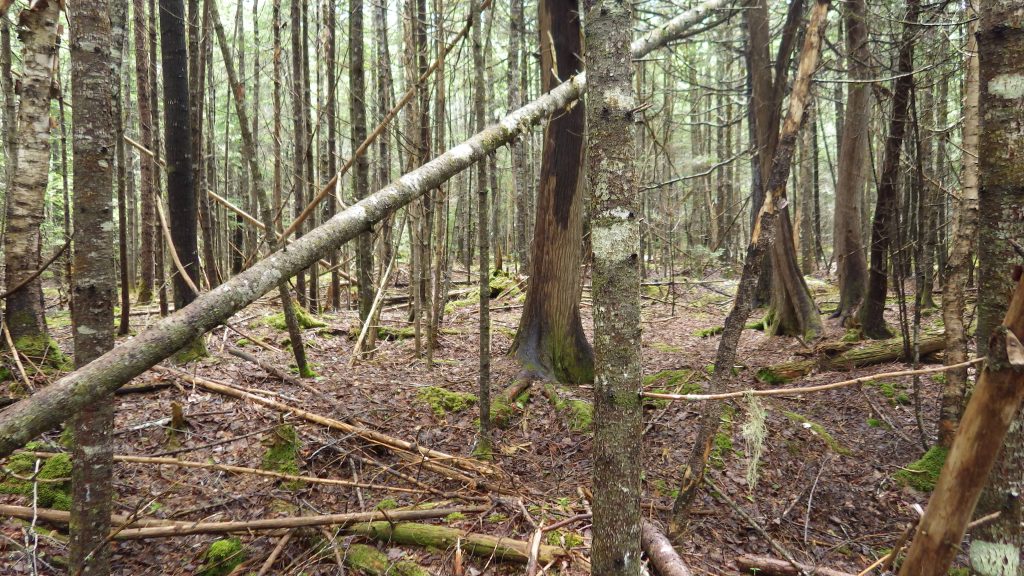 Coniferous forest consists of softwood trees. Coniferous forest is poor bee habitat. Although it provides some ground and ample cavity nesting resources, the lack of light in the understory does not allow many flowering plants to grow. Furthermore, the density of trees in coniferous forest is difficult for wild bees to fly through, making coniferous forest a potential barrier to accessing nearby patches of abundant floral resources. However, recently harvested patches of coniferous forest may provide high quality bee habitat for a few years until trees become dominant again.
Coniferous forest consists of softwood trees. Coniferous forest is poor bee habitat. Although it provides some ground and ample cavity nesting resources, the lack of light in the understory does not allow many flowering plants to grow. Furthermore, the density of trees in coniferous forest is difficult for wild bees to fly through, making coniferous forest a potential barrier to accessing nearby patches of abundant floral resources. However, recently harvested patches of coniferous forest may provide high quality bee habitat for a few years until trees become dominant again.
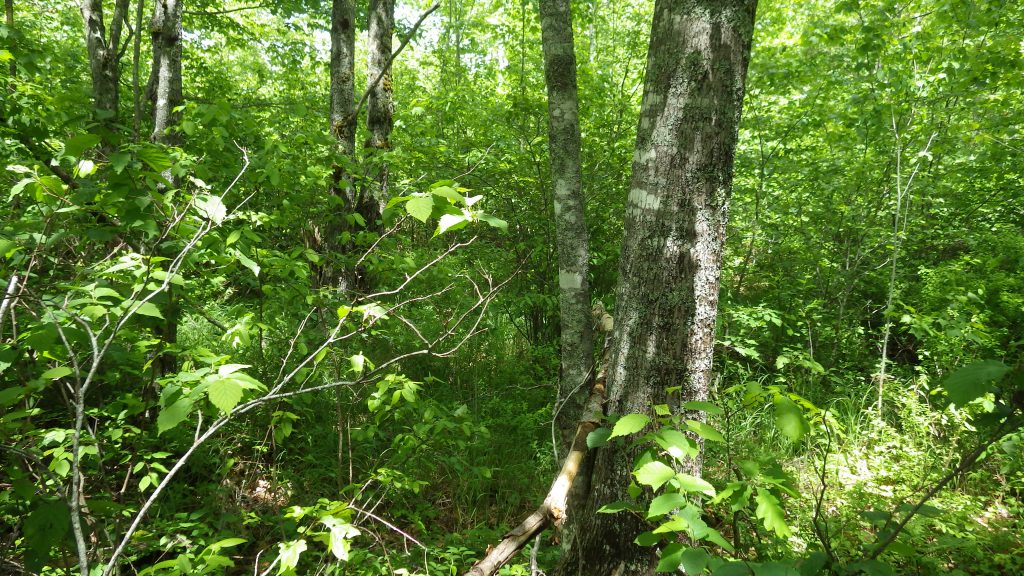 Deciduous/mixed forest consists of hardwood or a mixture of hardwood and softwood trees. This is moderate quality bee habitat, providing some ground nesting resources and ample cavity nesting resources. Sunlight through the tree canopy allows some wildflowers and flowering shrubs to provide pollen and nectar for wild bees throughout the growing season. Flowering trees, particularly maple, are a crucial pollen and nectar source in the early spring and provision many wild blueberry pollinating wild bees.
Deciduous/mixed forest consists of hardwood or a mixture of hardwood and softwood trees. This is moderate quality bee habitat, providing some ground nesting resources and ample cavity nesting resources. Sunlight through the tree canopy allows some wildflowers and flowering shrubs to provide pollen and nectar for wild bees throughout the growing season. Flowering trees, particularly maple, are a crucial pollen and nectar source in the early spring and provision many wild blueberry pollinating wild bees.
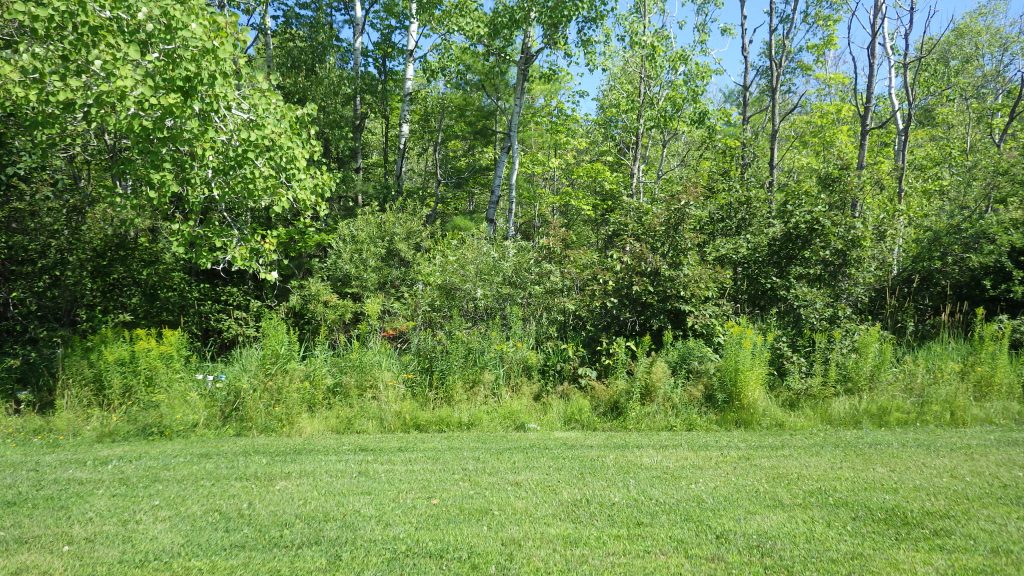 Deciduous/mixed forest edge is the transition between forests with hardwood or a mixture of hardwood and softwood trees and another land cover type. This is very high quality bee habitat, with excellent ground and cavity nesting resources. Woody shrubs provide hollow twigs, and bare patches of sandy soil are common. There are also plenty of wildflowers and flowering shrubs and trees to provide pollen and nectar throughout the growing season. Wild bee communities in edge habitat are very diverse and abundant owing to these ample resources. Forest edge along wild blueberry fields makes great habitat for wild bees.
Deciduous/mixed forest edge is the transition between forests with hardwood or a mixture of hardwood and softwood trees and another land cover type. This is very high quality bee habitat, with excellent ground and cavity nesting resources. Woody shrubs provide hollow twigs, and bare patches of sandy soil are common. There are also plenty of wildflowers and flowering shrubs and trees to provide pollen and nectar throughout the growing season. Wild bee communities in edge habitat are very diverse and abundant owing to these ample resources. Forest edge along wild blueberry fields makes great habitat for wild bees.
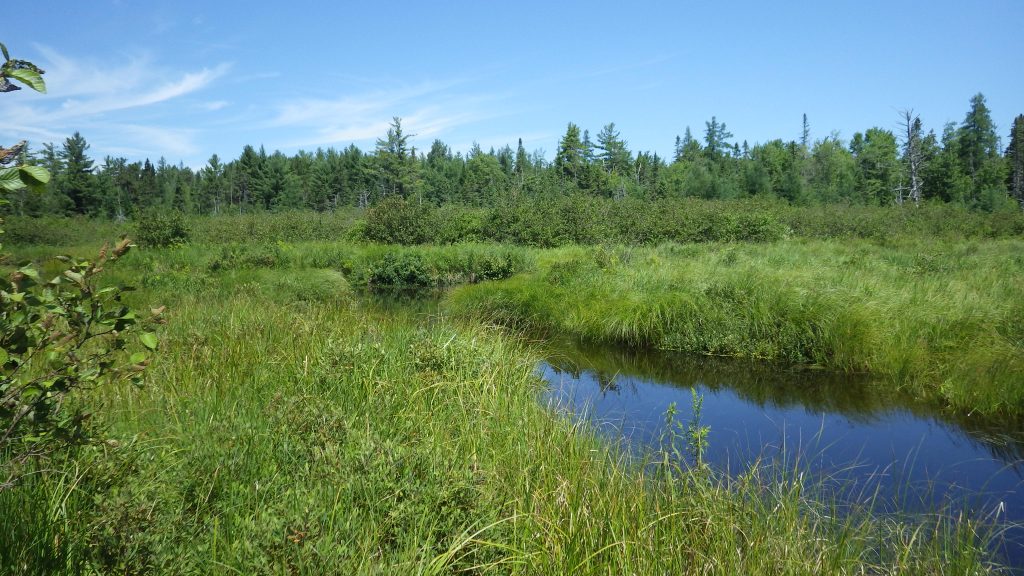 Emergent wetland is wetland habitat that is not consistently submerged throughout the growing season. It provides moderate quality bee habitat. Ground nesting resources are limited owing to wet soils, but cavity nesting resources are plentiful among the abundant woody shrubs and hollow flower stems. Emergent wetland provides a unique set of blooming plants to wild bees, including woody shrubs, bog plants and close relatives of wild blueberry. They are a good source of pollen and nectar throughout the growing season. Their proximity to blueberry fields in the Downeast region is important for wild bee population survival.
Emergent wetland is wetland habitat that is not consistently submerged throughout the growing season. It provides moderate quality bee habitat. Ground nesting resources are limited owing to wet soils, but cavity nesting resources are plentiful among the abundant woody shrubs and hollow flower stems. Emergent wetland provides a unique set of blooming plants to wild bees, including woody shrubs, bog plants and close relatives of wild blueberry. They are a good source of pollen and nectar throughout the growing season. Their proximity to blueberry fields in the Downeast region is important for wild bee population survival.
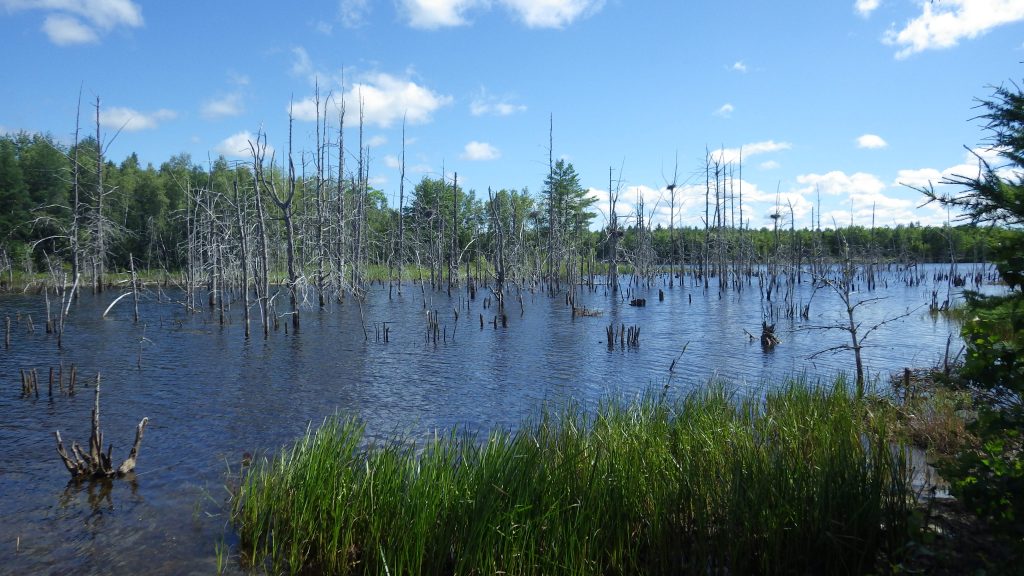 Wetlands/water consists of either submerged wetlands or open water. These areas are typically poor bee habitat—owing to the dominance of open water, they provide almost no ground nesting and few cavity nesting resources. Furthermore, they offer little pollen and nectar throughout the growing season as few flowering plants can establish in the wet soils. Submerged wetlands can offer cavity nesting resources in standing dead wood or hollow twigs and stems and may have flowering plants available at the water’s edge.
Wetlands/water consists of either submerged wetlands or open water. These areas are typically poor bee habitat—owing to the dominance of open water, they provide almost no ground nesting and few cavity nesting resources. Furthermore, they offer little pollen and nectar throughout the growing season as few flowering plants can establish in the wet soils. Submerged wetlands can offer cavity nesting resources in standing dead wood or hollow twigs and stems and may have flowering plants available at the water’s edge.
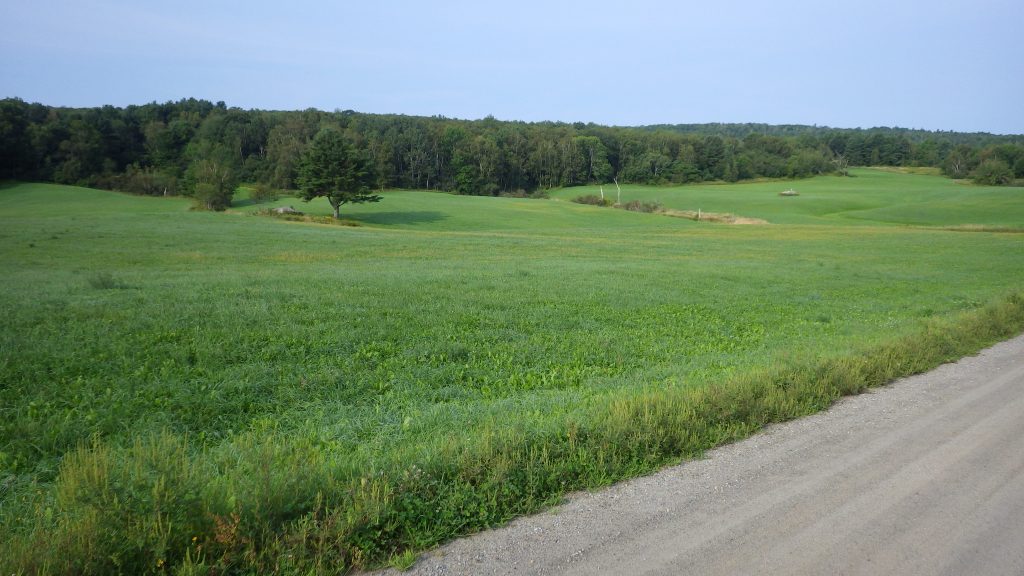 Agriculture/Grassland is either non-blueberry agriculture or open, grass-dominated fields. These areas provide moderate quality bee habitat. Agricultural and grassland areas provide ground nesting resources via exposed patches of soil if the soil is not compacted from heavy farm machinery, but a lack of woody shrubs and woody debris means they provide few cavity nesting resources. Abundant flowering plants can provide ample pollen and nectar to wild bees throughout the growing season, especially on small, diversified farms and grassy fields with constant wildflower bloom.
Agriculture/Grassland is either non-blueberry agriculture or open, grass-dominated fields. These areas provide moderate quality bee habitat. Agricultural and grassland areas provide ground nesting resources via exposed patches of soil if the soil is not compacted from heavy farm machinery, but a lack of woody shrubs and woody debris means they provide few cavity nesting resources. Abundant flowering plants can provide ample pollen and nectar to wild bees throughout the growing season, especially on small, diversified farms and grassy fields with constant wildflower bloom.
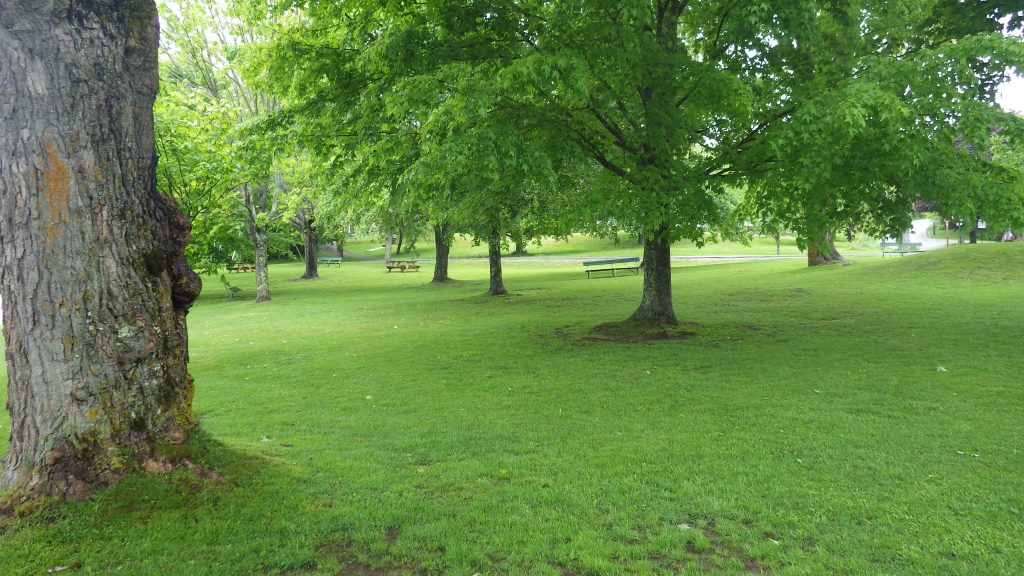 Urban/Developed consists of any kind of development, including roads, towns, and cities. Urban/Developed areas provide high quality bee habitat. They have excellent ground nesting resources in exposed sandy soils found along roadsides and in gardens, parks, and yards. Cavity nesting resources are also abundant in woody shrubs used for landscaping. Flowering plants are also abundant throughout the growing season from gardens, landscaping in public and residential areas, and fallow strips along roadsides. Reduced lawn mowing and pesticide applications are encouraged in urban/developed areas to promote wild bee populations.
Urban/Developed consists of any kind of development, including roads, towns, and cities. Urban/Developed areas provide high quality bee habitat. They have excellent ground nesting resources in exposed sandy soils found along roadsides and in gardens, parks, and yards. Cavity nesting resources are also abundant in woody shrubs used for landscaping. Flowering plants are also abundant throughout the growing season from gardens, landscaping in public and residential areas, and fallow strips along roadsides. Reduced lawn mowing and pesticide applications are encouraged in urban/developed areas to promote wild bee populations.
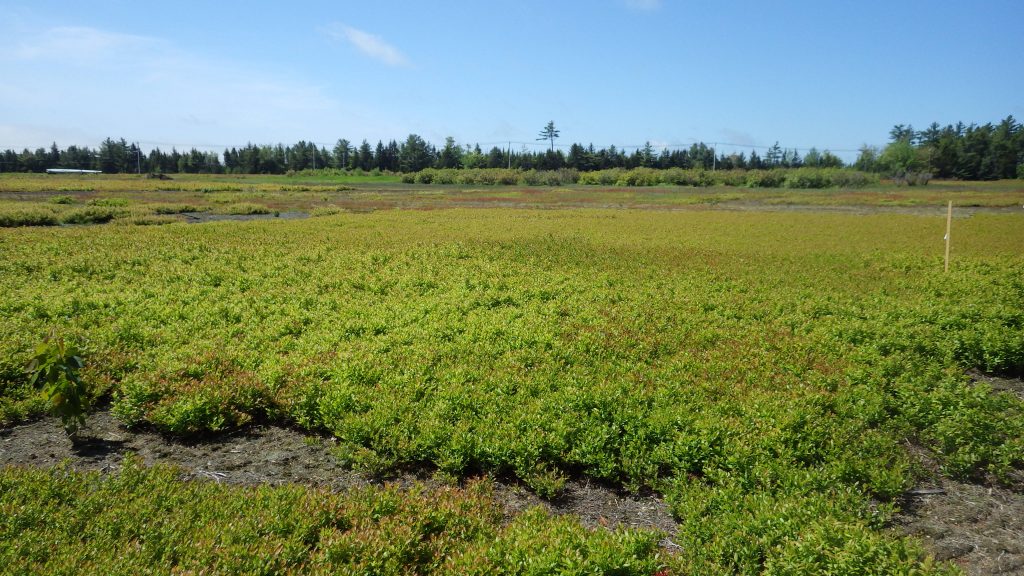 Blueberries includes blueberry fields that may be managed or unmanaged. Blueberry fields provide moderate quality bee habitat. There are excellent ground nesting resources owing to patches of exposed, sandy soils, but few cavity nesting resources within blueberry fields. The crop bloom in late spring provides an incredible source of food for wild bees, but there is little pollen and nectar throughout the rest of the growing season. Wild bees rely on nearby habitat to sustain their populations post-crop bloom, therefore it is crucial to have ample floral resources nearby. Unsprayed field edges and installed pollinator plantings can promote wild bee habitat in blueberry fields.
Blueberries includes blueberry fields that may be managed or unmanaged. Blueberry fields provide moderate quality bee habitat. There are excellent ground nesting resources owing to patches of exposed, sandy soils, but few cavity nesting resources within blueberry fields. The crop bloom in late spring provides an incredible source of food for wild bees, but there is little pollen and nectar throughout the rest of the growing season. Wild bees rely on nearby habitat to sustain their populations post-crop bloom, therefore it is crucial to have ample floral resources nearby. Unsprayed field edges and installed pollinator plantings can promote wild bee habitat in blueberry fields.
